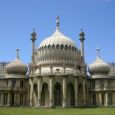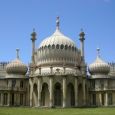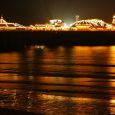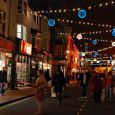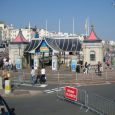Brighton
Advertisement
By Air
Most visitors who arrive by air make use of London Gatwick Airport, located 28 miles north of Brighton and linked to Brighton by a direct rail connection. The airport provides regular connections to many UK, European and international destinations. Shoreham Airport, just 20 minutes to the west of Brighton by car, is a small regional airport serving domestic and French destinations, including the Channel Islands. Airlines operating out of Shoreham Airport include Skysouth and Blue Islands.
By Rail
Brighton is served by the extensive National Rail network, providing connections to destinations all over the UK. The trip to Southampton takes 1 hour 40 minutes, while from London the journey can be made in around 1 hour. From Dover it takes 2 hours 30 minutes. Brighton Station is located on Queens Road.
By Bus
National Express operates an extensive coach network around the UK, and connects Brighton to all destinations. The bus and coach station is located in Pool Valley, near the city centre.
By Car
From London, Brighton can be reached via the M25 London motorway and then taking the M23/A23 to Brighton and Hove. The A27, a coastal route, links the city to Southampton in the west and Eastbourne in the east.
Royal Pavilion
The Royal Pavilion in the center of Brighton was built between 1815 and 1823 in the Indian Mogul style, as the summer residence of the Prince of Wales. John Nash was the architect, with Frederick Crace and Robert Jones responsible for the interior. It remains one of the town's principal landmarks. Visitors enter the Pavilion through the Octagon Hall, passing via an antechamber into a long corridor with Chinese ornamentation. Note the fine cast iron banisters in imitation of bamboo. To the right of the corridor is the Banqueting Room with its astonishing oriental décor. This includes a chandelier of lotus shaped lamps protruding from the jaws of six chimerical creatures, all suspended from a silver dragon emerging from a cluster of palm fronds. In the Music Room to the left of the corridor more huge serpents and winged dragons adorn the domed, almost tent like room (the gas lamps were a technical novelty at the time and evoked considerable wonder). A similar indulgence in the exotic and the extraordinary prevails in the other rooms of the Pavilion, the exception being the prince's own private apartments which are in contrast plain. "Prinny's" passion for splendor provoked a popular outcry, caricaturists ridiculing his lavish lifestyle and eccentricities of taste. Queen Victoria eventually sold the outrageously extravagant palace for £50,000 to the town, which has been responsible for the building ever since.
Museum and Art Gallery
Situated in the former royal stables and riding school the museum possesses an outstanding collection of Art Deco pieces, with some particularly fine Art Nouveau furniture. There is also a costume gallery with fashions from the 18th century onwards, a display of old musical instruments, and the excellent Willet Collection of porcelain and ceramics.
The special strength of this costume collection is a collection of examples from the 1920s and 1930s.
Palace Pier
No more than a few paces from the Old Steine lie the sea front and promenade, set off in spectacular fashion by the long iron pier. The original Chain Pier of 1823, immortalized in a painting by Constable (1827), was wrecked by a storm in 1869, while the West Pier (1866), although still standing, is derelict. Only the 1700ft/520m-long Palace Pier (1891-1899) with its volute ironwork remains in use, jutting out to sea like the upper deck of a steamer on spindly iron legs. The days when the pier was fashionable have long since gone, replaced by a culture of amusement arcades and snack bars.
The Lanes
The center of the old fishing village of Brighthelmstone once stood on the site of the narrow alleyways known as The Lanes, where the charming little 17th century cottages have mostly been turned into antique shops, boutiques and cafes. Some of the facades are still "weather boarded", colorfully clad with painted wooden boarding as protection against wind and weather.
Sea Life Centre
At the Brighton Sea Life Centre visitors can take close-up looks at live sharks, stingrays, starfish and other sea creatures. The underwater viewing tunnel is particularly interesting.
Information not available


